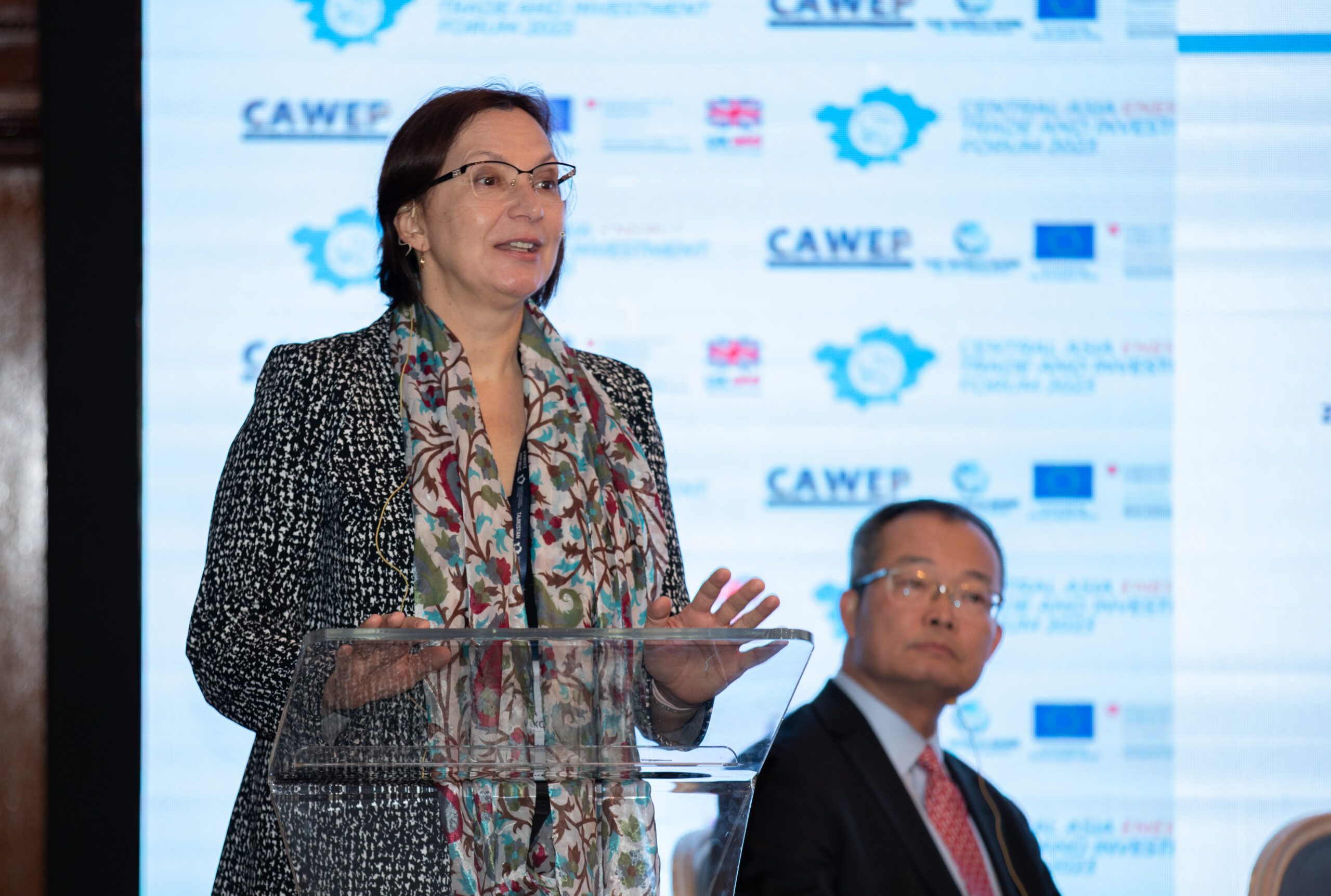ASTANA – As energy transition remains a priority for Central Asia, the World Bank is committed to support the region in promoting efficient mechanisms for regional electricity trading and developing joint actions to improve regional cooperation and activities that contribute to the transition to a carbon neutral economy.

Tatiana Proskuryakova, the World Bank Regional Director for Central Asia. Photo credit: World Bank.
On March 2-3, Central Asia Energy Trade and Investment forum brought together policymakers from Kazakhstan, Kyrgyz Republic, Tajikistan and Uzbekistan to discuss current trends and challenges in this field.
Following the forum, Charles Cormier, the World Bank Regional Director for Infrastructure, Europe and Central Asia and Tatiana Proskuryakova, the World Bank Regional Director for Central Asia, spoke about the energy issues in the region and the key conference outcomes in an exclusive interview with The Astana Times.

Central Asia Energy Trade and Investment Forum 2023 was held in London on March 2-3. Photo credit: World Bank.
What are the main opportunities and challenges in the energy systems in Central Asia?
Central Asia is emerging from a challenging winter, which brought the lowest regional temperatures in decades. Outdated infrastructure—from power generation and heating to water supply—struggled to manage the strain region-wide. And of course, you remember last winter’s blackout, which threw several major cities across Kazakhstan, Kyrgyz Republic, and Uzbekistan into chaos. The outage affected heating, water and electricity services to households and small and medium enterprises, as well as healthcare and education facilities, and created traffic jams as traffic lights were out.
These incidents, against the backdrop of rapidly growing power demand across the region, underscore the need for urgent action on energy security – the idea that energy services should be reliable and affordable, and preferably reliant on more than one source of supply. Since independence, Central Asian countries have relied on their national resource endowments for most of their electricity generation – coal in Kazakhstan, gas in Uzbekistan and Turkmenistan, and hydropower in Kyrgyz Republic and Tajikistan. Despite these resources, countries face challenges in keeping up with investments needed to meet growing electricity demand, driven by strong economic growth, and aspirations of their population for increased standards of living and basic needs for increased heating in cold weather. At the heart of the matter is the need to attract investments – from the private and public sectors – and ensure adequate returns. In addition, Central Asian countries use energy inefficiently, two to three times more energy per unit of GDP compared to, for example, countries in the European Union, due to poor insulations in buildings and slow adoption of the latest energy efficient technologies.
The good news is that the region has both the natural resources endowment and the human capital needed to embrace both sides of the clean energy transition – a massive shift in energy supply towards cleaner sources, coupled with a significant reduction in energy demand through energy conservation and efficiency. Already, both Kazakhstan and Kyrgyz Republic have committed to the aspirational goal of achieving carbon neutrality by 2060 and 2050 respectively, and most of the region is aligning with international agreements like the Paris Accord. In addition, prices for renewable energy – in particular solar and wind – have significantly come down – and become competitive with conventional sources of energy. And clean hydropower at scale remains cost competitive in the region.
Indeed, all of the Central Asian countries boast significant untapped clean energy resources, which are also among the most affordable globally. Take power systems in both the Kyrgyz Republic and Tajikistan, which use hydropower resources for 80 percent and 90 percent, respectively, of their total demand. They have a lot more hydropower potential, and this clean energy could be exported within Central Asia, and to South Asia. In addition, there is sufficient solar potential in Uzbekistan, Turkmenistan, Tajikistan and Kyrgyz Republic, and wind in Kazakhstan to achieve net zero emissions in the power sector.
Is carbon neutrality realistic for Kazakhstan – given its main export revenue is oil, and its main electricity production is sourced from its vast coal reserves?
With the right policy environment, achieving carbon neutrality is not only realistic but it can also support improved economic resilience and sustainable growth in Kazakhstan. Decarbonization can spur a modernization of industry and infrastructure as part of transition to a greener economy. But to take advantage of these opportunities, Kazakhstan needs to strengthen the prerequisites for developing dynamic and competitive new markets, in particular, competition and innovation policy, state-owned enterprise (SOE) reform, and improved finance and investment frameworks. This is consistent with Strategy Kazakhstan 2050, which sets out Kazakhstan’s plan to transition away from an energy- and emissions-intensive economy to a greener path. The World Bank analysis identifies three potentially important areas of economic opportunity for Kazakhstan: (i) clean energy, including green hydrogen, (ii) minerals critical for the low-carbon transition, and (iii) potential to enrich participation in green value chains based on existing production capabilities.
Our assessment indicates that domestic decarbonization could act as a significant economic stimulus and insurance against the shocks of rapid global decarbonization, with real GDP two percentage points higher in 2040 and 2.7 percentage points higher in 2060 in the scenario where Kazakhstan acts relative to a business- as-usual scenario.
Let’s discuss the regional electricity market in more detail. What is the rationale, how realistic is it and will the World Bank support its development in Central Asia?
Stronger regional electricity trade, supported by grid modernization, can effectively address national electricity supply-demand imbalances across the region – and contribute to decarbonization targets across the region. For instance, affordable hydropower resources can provide energy when solar and wind resources are not available due to their intermittency.
Although Central Asian electricity systems are already interconnected, the exchange of power among countries is very limited for historical reasons. Only 2.5 percent of energy demand in Central Asia is currently met through trade, amounting to about 40 percent of interconnection capacity. Reasons for such low performance include the lack of a market framework and the absence of effective regional coordination.
A regional electricity market is technically complex, but certainly manageable, and we have plenty of successful examples from around the world to draw upon. Based on our global experience with regional electricity markets, and over three decades of partnership in Central Asia, we are proposing a flexible, decentralized approach that would allow countries to control their national markets and power systems. Minimum harmonization of market rules would allow for rapid rollout and complement longer-term bilateral trade contracts, without large-scale regulatory changes at the outset.
The bank gathered governments of Central Asia in London for an energy trade and investment forum on March 2-3. What was achieved at the forum?
The forum made important strides in bringing together public- and private-sector leaders to chart a course for the future of the secure and clean energy transition in Central Asia. We have reached an agreement to pilot a “day-ahead” electricity market – as a first step towards a fully-fledged electricity market – that will help build trust in trade, improve generation and interconnectivity, enable commercial solutions to energy shortages such that were experienced earlier this year, lower costs for participants by introducing competition, and demonstrate this can work. We will also support key investments promoting interconnectivity in the region to be further identified with each participating country. Establishment and operationalization of regional institutions is also at the core of our proposed support package.
At the forum, the World Bank and its partners also identified about $20 billion worth of no-regret investments needed to improve interconnectivity and electricity trade in the next five years, with total needs estimated at $150 billion by 2030. The goal is to advance reforms that would enable these investments, which would propel Central Asia’s energy transition forward to decarbonization and a clean energy mix, and away from over-dependence on fossil fuels and increasingly obsolete regulatory models.
What are your main recommendations to the governments of Central Asia to ensure stable supply of electricity?
To put it briefly, the main challenge is to enable Central Asian energy systems to be financially sustainable, and attract the investments needed. In order for that to happen, countries need to implement a series of reforms aimed at achieving cost reflective tariffs for those with the ability to pay, while providing subsidies only for the poor and vulnerable. Strong political commitment to reforms is the foundation for ensuring stable, sustainable and affordable supply of electricity in Central Asia. These reforms include gradual removal of fossil fuel subsidies, enhancing sector governance and transparency, strengthening the planning and commercial frameworks, as well as removing existing technical and regulatory barriers for the development of renewable energy in the region. Successful, timely and consistently implemented reforms will build trust in trade and open doors to investments that will help facilitate the development of the regional electricity market.

